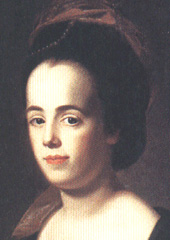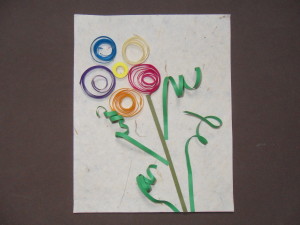Judith Sargent Stevens Murray born into a wealthy Congregationalist home. At the age of 18, she married John Stevens, the son of a prominent Gloucester, Massachusetts family. When Judith’s father, Winthrop Sargent, read Union or A treatise of the Consanguinity of Affinity Between Christ and His Church by James Relly, he and his family began to embrace the new theology Relly proposed.
In 1774, the English Universalist preacher, John Murray, was lecturing in Boston and Judith’s father invited him to their home. John Murray and Judith met for the first time and began a correspondence discussing theology and later, the revolt of the colonies against the British. John Murray, accused of being a spy, accepted a job as army chaplain to avoid expulsion from the colonies. In the meantime, the Congregationalist church suspended Judith, her father and several other members. The following year, these Gloucester Universalists signed Articles of Association and formed the Independent Church of Christ. In 1780, John Murray became their first pastor.
Judith embraced her new religion and became a religious educator for the Universalist children of Gloucester. She and her husband adopted his two nieces and a cousin. She compiled and published the first Universalist catechism written by a woman. In it, she declared that men and women are equal, a central belief of the Universalist church.
In 1786, John Stevens escaped to the West Indies to escape creditors and died. Judith married John Murray in 1788.
Judith began writing poetry under the name “Constantia” She wrote essays on politics, manners, women’s role in society and religion for the periodicals of the day. She published under assumed names because she believed her writings would be taken seriously if the public didn’t know the writer was a woman.
Gentleman and Lady’s Town and Country Magazine published her essay, “Desultory Thoughts Upon the Utility Encouraging a Degree of Self-Complacency, Especially in Female Bosoms” in 1784. In 1792, she began to write a column in Massachusetts Magazine and chose the pen name Mr. Gleaner. She also began another column for the same magazine as Constantia. For Thomas Paine’s The Federal Orrery, she wrote a series of five articles for the The Reaper column. Paine edited and rewrote some of her material and she vowed to never write another column again. The themes of her writings included Universalism and the political and social issues of the day. She also wrote plays and continued to write poetry published in the Boston Weekly Magazine writing as Honoria Martesia.
In the colonies, tutors or their mothers instructed women from wealthy families. A small minority attended the few schools in existence which were private schools for the wealthy. As early as 1784, Murray publicly urged that girls get an education.
In a 1790 essay, “On the Equality of the Sexes,” she asserted that men and women were equally capable of acquiring knowledge but differences in their education “resulted in inadequate instruction of women.” Murray felt she received an inferior education compared to her brother and learned on her own by reading. This experience taught her that women and men should have the same access to educational opportunities.
Murray’s legacy as a writer and educator continues to this day, In 1974, Alice Rossi included “On the Equality of the Sexes,” in The Feminist Papers ensuring Judith Sargent Stevens Murray’s place in women’s history.
Additional Bibliography:
Smith, Bonnie Hurd, Mingling Souls Upon Paper: An Eighteenth-century Love Story) Hurd Smith Communications, 2008.
Diamant, Lincoln, editor. Revolutionary Women in the War for American Independence, A One Volume Revised Edition of Elizabeth Ellet’s 1848 Landmark Series. Westport Connecticut: Praeger Publishers, 1998.
Greenberg, Judith E. and McKeever, Helen Cary. Journal of a Revolutionary War Woman. New York: Franklin Watts, 1996.
Micklos, John. The Brave Women and Children of the American Revolution. Berkeley Heights, NJ: Enslow Publishers, Inc, 2009
Freeman, Land M., North, Louise V and Wedge, Janet M. In the Words of Women: the Revolutionary War and the Birth of the Nation, 1765-1799. Landam, Md: Lexington Books, 2011.
Redmond, Shirley Raye. Patriots in Petticoats, Heroines of the American Revolution.New York: Random House, 2004
MATERIALS:
Strips of quilling paper 1/8 inches to ½ inches in width
Scissors
Clear glue
Pencil or Q-tip
Colored paper or card stock
Light-weight paper in various colors (optional)
Ruler (optional)
PROJECT:
- Purchase quilling paper which comes in a variety of colors. Or using a ruler, measure and mark anywhere 1/8” to ½” at intervals along the length of the lightweight paper. Draw a long line along the marks. Cut and repeat the steps until you have enough strips for a design.
- Roll the end of the paper on to the end of a pencil or Q-tip. When you reach the end, loosen a little of the coil so you can easily roll it off the pencil. Add a little glue and finish rolling the coil to keep it from loosening.
- Roll the coils tightly and/or loosely depending on your design. Look at the sample above.
- Arrange the coils on the colored paper or card stock creating a design: flowers, butterflies, dragonflies, abstract designs. Quilled paper designs can also be framed (without glass) and hung in any room or classroom.





